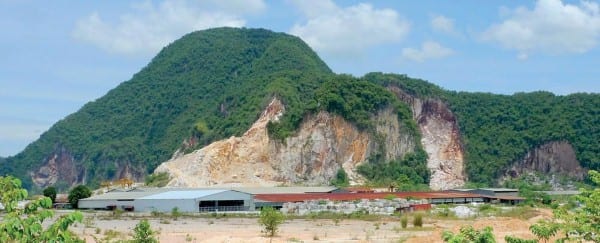Thriller set in Bangkok and Ko Samet
Novel set in 1940s Ipoh, Malaya plus author talks about locale
29th August 2017
When The Future Comes Too Soon by Selina Siak Chin Yoke, novel set in 1940s Ipoh, Malaya.
There is much more written about the effect of WW2 on Europe, the States, and perhaps from an English perspective about the effect on Singapore, so it was very interesting to read a little more about the Japanese invasion of Malaysia through the eyes of Mei Foong, her husband Weng Yu and her family. The Malaysian peninsula endured so much more than being a simple route to Singapore from Japan, which the Japanese, as is well known, navigated on bicycles to get south.
The story starts in 1942, the Japanese Imperial Year of 2602, with the Japanese invasion of Malaya, as it was called then. It is a story of family and fear and how gradually the Malayan culture became subsumed by the Japanese – or as this author calls them, the “Japs” – as they beavered away to impose Japanese culture and mores on an unwilling populace, riding roughshod over the largely acquiescent people. Traitors’ heads were spiked above the market as a warning to others, the local currency had to be traded for Japanese Dollars on a one to one ratio, inflation was rampant, and all the while the people were being edged towards blind obedience to the Japanese Emperor.

View from the top of Kledang Hill Photo © SSCY
Food, locale and culture are all central to the narrative, and observations from the era often feel really pertinent. The family’s lifeline for news – and of the British departure as the Japanese invade – was their Philco wireless set, which they soon had to give up. There is good detail in many aspects. In fact the book is written as one would imagine language to have been spoken at the time, BBC English, formal and slightly clipped, and although this is perhaps era correct, it can leave the prose feeling a little wooden and impersonal. I struggled to hear the individual voice of the author, and phrases such: “She had caught my interaction … and took in my fluster” lent the narrative at times an old-fashioned edge.
Overall a read that will expose the terrible times in Malaya in World War II, a read that is at times as colourful as it is visceral.
Tina for the TripFiction Team

Tub of bean sprouts Photo © SSCY
Over to Selina who tells us more about the stunning location of Ipoh itself in our #TalkingLocationWith… feature.
I chose to locate both When the Future Comes Too Soon and my first novel, The Woman Who Breathed Two Worlds, in my hometown of Ipoh in Malaysia.
This locale made literary sense! But even though I knew the town, I saw Ipoh in a new light while writing these books. For the first time, I had to try to imagine what life was like for people in bygone days. Unlike us, my characters would have walked. And as they walked, I realised that they would have seen the limestone hills which surround Ipoh from almost anywhere.

Night scene market Photo © SSCY
Now, I had always known about Ipoh’s limestone hills – they even loom in my memories. But when things are familiar, you take them for granted.
For my characters, though, the town and its hills – blue on clear days, dreamy on grey days, dark during thunderstorms – kept them company. At some point the town and its hills came alive for me. Gradually, Ipoh became more than a mere setting; it became a character, its moods gauged by the way the surrounding hills looked.
I was not the first to be captivated by Ipoh’s hills. Taoist-Buddhist monks found them so wondrous that they built their temples inside the caves found beneath these hills. The earliest such edifice dates back to the late 1800s. There are now several cave temples, each one a tourist attraction, including the Sam Poh Temple described in my novels.

Inside Kuan Yin Temple Photo © SSCY
Because I was writing historical fiction, I did copious amount of research into the town’s history. Ipoh looks utterly different now, and I had to find maps of old Ipoh to plot out the routes my characters would have taken. I re-visited all of the spots mentioned in my novels: the missionary schools, the large field in the former heart of colonial Ipoh where the Japanese army sent Chinese men to stand in the midday sun, and of course, the cave temples.
Ipoh was once a burgeoning mining town. Alongside the limestone, rich deposits of tin were discovered in the plain on which Ipoh is situated. The town grew during the mining frenzy which followed, attracting a host of talent, including the best cooks of the day. It became known for delicious food and great produce, especially – wait for this – the humble bean sprout.

Photo: IpohEcho.com
Bean sprouts are an Ipoh speciality. My hometown’s bean sprouts are juicier and fatter than those I’ve sampled anywhere else – with a crunchiness all their own. Locals believe this is because they are fed water from those limestone hills.

Cooks at Lou Wong Photo © SSCY
Thanks to its quality bean sprouts, Ipoh has become known for chicken and bean sprouts: steamed or roasted chicken eaten with rice or rice noodles and bean sprouts cooked simply, blanched and then quickly doused with soy sauce and sesame oil. There are restaurants serving only this dish and nothing else, the most famous being Lou Wong. I’m always hesitant about divulging my favourite places, lest they be invaded, but I’m safe with this tip – they’re already on TripAdvisor!
Thank you to Selina for transporting us to Ipoh. You can follow her on Twitter
Twitter (@TripFiction), Facebook (@TripFiction.Literarywanderlust), YouTube (TripFiction #Literarywanderlust), Instagram (@TripFiction) and Pinterest (@TripFiction)
We pick two titles which take place in the periods after WW2 to get you started and do search our full database:
 The Separation by Dinah Jeffries
The Separation by Dinah Jeffries
A country at war with itself, a family divided and betrayed, a bond that can never be broken…
Malaya, 1955. Lydia Cartwright returns from visiting a sick friend to an empty house. The servants are gone. The phone is dead. Where is her husband Alec? Her young daughters, Emma and Fleur?
Fearful and desperate, she contacts the British District Officer and learns that Alec has been posted up country. But why didn’t he wait? Why did he leave no message?
Lydia’s search takes her on a hazardous journey through war-torn jungle. Forced to turn to Jack Harding, a man she’d vowed to leave in her past, she sacrifices everything to be reunited with her family.
 The Garden of Evening Mists by Tan Twan Eng
The Garden of Evening Mists by Tan Twan Eng
Shortlisted for the Man Booker Prize 2012. It’s Malaya, 1949. After studying law at Cambrige and time spent helping to prosecute Japanese war criminals, Yun Ling Teoh, herself the scarred lone survivor of a brutal Japanese wartime camp, seeks solace among the jungle fringed plantations of Northern Malaya where she grew up as a child. There she discovers Yugiri, the only Japanese garden in Malaya, and its owner and creator, the enigmatic Aritomo, exiled former gardener of the Emperor of Japan. Despite her hatred of the Japanese, Yun Ling seeks to engage Aritomo to create a garden in Kuala Lumpur, in memory of her sister who died in the camp. Aritomo refuses, but agrees to accept Yun Ling as his apprentice ‘until the monsoon comes’. Then she can design a garden for herself. As the months pass, Yun Ling finds herself intimately drawn to her sensei and his art while, outside the garden, the threat of murder and kidnapping from the guerrillas of the jungle hinterland increases with each passing day. But the Garden of Evening Mists is also a place of mystery. Who is Aritomo and how did he come to leave Japan?


 Please wait...
Please wait...
